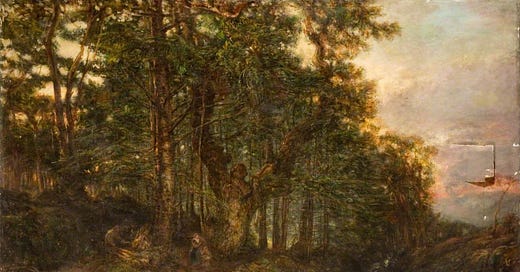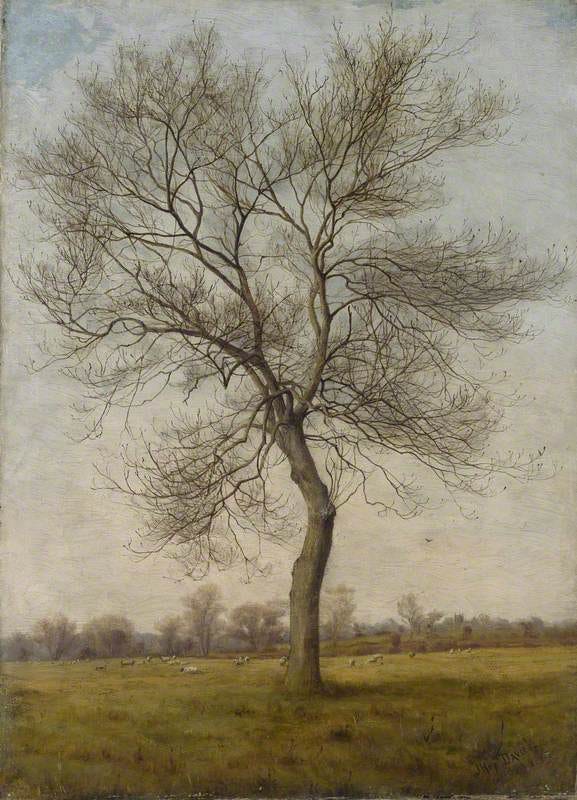How is everybody doing? Here in our Pennsylvania woods the bloodroot flowers have appeared on sunny slopes, and in my own woodland garden, our pagoda trout lilies are days away from blooming. These trout lilies differ from the ones appearing in forests, but I must confess, they are so stunning I forgive them for being non-native cultivars.
What have you been reading? Of course, I’m reading Wuthering Heights. I’m closely reading it, in fact, because we are about halfway through my nine week read-along.
This Sunday I’ll post a summary of the three chapters which inspired me to create a Substack entirely dedicated to a single novel. Wuthering Heights was written between the autumns of 1845-1846 and published in December 1847. The 1847 edition of the novel was printed as three volumes; Emily’s novel encompassed two volumes while her sister Anne’s novel, Agnes Grey, concluded the publication.
Weird, right? It was a thing at the time—publishing multiple stories in a single edition.
Last week I struggled with writing a summary essay for Week Four of the read-along. It is spring after-all and everything is greening up. I took a walk to clear my head. My son and I explored a nearby area—home to five abandoned lime kilns—and we had a splendid day immersed in Nature.
A member of my read-along community recently mused about the lack of Nature in Wuthering Heights, despite Catherine and Heathcliff’s infamous associations with the English moors. I understand why someone might be curious!
The first three chapters of Volume Two contain a number of the seasonal, weather-related images we crave but they’re strewn among scenes of brutality. I’m sure you’ve noticed: Wuthering Heights is steeped in beauty and bloodshed.
Love and Nature can be brutal, though, can they not?
If you’ve read Wuthering Heights you likely know why I chose March 20 as the date to begin my read-along—it is important to Catherine Earnshaw and Catherine Linton. And oft times, the Spring Equinox falls on the twentieth day in March. If you’ve not signed up to be part of my read-along, join-in now! No paywalls—each assignment commences on a Thursday; and on Sundays I publish my summary essays. Join us!1
Our Week Five reading assignment begins with Volume Two (Chapters 1-3). In single-volume editions this assignment will be Chapters 15-17. It is here Emily Bronte finally describes her landscape, this is where she immerses us in the weather and atmosphere of this, ‘most beautiful and most profoundly violent love story.’2
Last evening—in preparation for writing my Week Five summary, I was examining the text and noticed the housekeeper’s account in the first paragraphs of Chapter 3 (17):
That Friday made the last of our fine days, for a month. In the evening, the weather broke; the wind shifted from south to north-east, and brought rain first, and then sleet and snow.
On the morrow one could hardly imagine that there had been three weeks of summer: the primroses and crocuses were hidden under wintry drifts; the larks were silent, the young leaves of the early trees smitten and blackened. And dreary, and chill, and dismal that morrow did creep over!
The Friday in question took place in late-March. Nelly Dean, housekeeper and lady’s maid to Catherine (Earnshaw) Linton refers to the ancient observance of two seasons: one, summer and the other, winter. The solstices were midsummer and midwinter.
What we currently think of as spring (March, April, May) was part of summer, and the months we consider autumn (September, October, November) fell partially at the end of summer (in harvest), partly in winter.3
City-dweller and tenant of Thrushcross Grange, Mr. Lockwood, has exclaimed at the beginning of the chapter that he is, ‘nearer health, and nearer spring!’ When Nelly refers to the time of year as summer, Brontë is nodding to the housekeeper’s rural rusticity. It is in fact, closer to the vernal equinox of 1784.
And so, of course, rain, sleet and snow are sometimes to be expected in the northern hemisphere this time of year—this very morning is cool and overcast. It’s this change in weather which sometimes stunts and damages, arrests and and kills, isn’t it?
Wuthering Heights has already gifted us firs, hawthorns, gooseberries, and holly. We’ve read of peat bogs and lime. Thunderstorms and snow, bleak winds and northern skies. Allusions to honeysuckles and furze, whinstone and coal. Doves and beasts, lambs and bulls. And in the midst of delirium: turkeys, wild ducks, pigeons and lapwings.
Nature is so delicately strewn throughout, it is overlooked and often, subtle. Tucked in crevices between dialogue and drama, mention of a lark goes unnoticed. Let’s see what we can tease out of this week’s read-along assignment…
‘By the Shine of the Westering Sun’
Emily Brontë uses the sun and moon, air and atmosphere to place her readers in space and time. ‘The weather was so warm and pleasant that I set [the doors] wide open,’ is how we are invited into the first chapter—a book lies on the windowsill before Cathy, ‘scarcely perceptible wind fluttered its leaves.’ Can’t you just imagine the scene—the early floral scents from the garden, the warmth of the sun, the soft breeze?
Our narrator, Nelly Dean, describes the scene. Gimmerton chapel bells are ringing. it is Sunday. ‘The full, mellow flow of the beck in the valley came soothingly on the ear. It was a sweet substitute for the yet absent murmur of the summer foliage, which drowned that music about the Grange when the trees were in leaf.’
Distinguishing the Heights from the Grange, Brontë informs us, ‘At Wuthering Heights,” its station exposed, ‘it always sounded on quiet days, following a great thaw or a season of steady rain…’
Are you familiar with these audible seasonal shifts? You needn’t live in the country to experience Nature-inspired increases and decreases in sound. An overcast sky pushes sound waves to the ground and they carry further. When the trees are bare, a train a few miles over might sound as if it is passing through your yard, but when they leaf out in spring, the noise is muffled and muted.
In this week’s assignment, readers experience a tense scene in which Heathcliff has entered the Grange unbidden. Edgar Linton—the master—is returning from church. Emily Brontë’s warm sunshine and church bells told us that at the beginning of the chapter and near its end she notes, ‘the afternoon wore fast away,’ and ‘by the shine of the westerling sun up the valley,’ parishioners could be observed leaving after the service had ended.
‘Those Larch Trees’
I live in a borough which spans only two square miles; the area is home to eighteen churches—the ring of church bells carries and on a Sunday, from most any elevated position the very same scene might play out. Edgar Linton, unfortunately, is going to find his beloved wife in the arms of her soulmate, Heathcliff, when he arrives home. Heathcliff exits her chamber, but not before informing the housekeeper, “I shall be under those larch trees.”
And so, we add the larch to our list of Brontë’s elements of Nature.
The larches are lovely trees—the tamarack (Larix laricina) is native to Pennsylvania. I’ve photographed them near my home. Deciduous conifers, larches produce cones and lose their needles in autumn. Larch trees are associated with the masculine; they are believed to possess magical properties which protect them from fire.
The exquisitely brilliant Brontë scholar, Stevie Davies wrote:
It is characteristic of the author to name the species of the tree rather than to refer to generalized trees. The larch is a fir but not ever-green, shedding its needles annually from delicate, slender boughs and with the spring re-clothing itself in soft pale-green. Mid-way between the evergreen and deciduous worlds, it looks like the one, behaves like the other…
Heathcliff now has a double nature: he both lives and does not live. Catherine, who is conceived of as his own being, will be buried and he left above ground, ‘with his soul in the grave.’4
Heathcliff may have waited for word about Catherine ‘among the larches,’ ah! but when he is discovered by housekeeper, Nelly Dean, he is leaning on an ash tree.
Heathcliff’s Grief
Do you remember my essay on the Clare Leighton woodcut, “Heathcliff’s Grief?” The Nature imagery in this scene is especially evocative—Stevie Davies, again, makes the most remarkable observations:
Heathcliff is absorbed in his waiting in the wood. He beats his head against the trunk of ash in his agony: “I observed several splashes of blood about the bark of the tree, and his hand and forehead were both stained; probably the scene I witnessed was a repetition of others enacted during the night.”
This extreme behaviour has often been seen as a bizarre intrusion of Gothic in which the obligatory maniac behaves like a howling beast rather than a man. But there is deeper, mythic meaning to these actions…
In [his] absolute loss, [Heathcliff] meets the boundaries of human nature but cannot get across. Nelly sees him as an animal. It is easier for her to formulate the idea of the non-human in these terms. The breeding [blackbirds] see him as a tree.
We see his blood shed upon the bark of the ash and staining it; his forehead too is stained with blood baptismally. In the image of the blood-stained tree Emily Brontë suggests an analogy to the sacrificial slaughter either of animal or man, by which the ancient mystery religions sought to appease the deities and ensure a fruitful new year. Heathcliff’s pain is absolutely acute. The year, the hour, the day turn; the baby is born, the birds mate. The old mother passes, while the man’s blood, like that of the sacrificial king of ancient pagan religions, seeps into mother earth.
If this all seems a bit dark, think of Ronald Hutton wassailing apple trees in those wonderfully entertaining Ruth Goodman specials—it’s not so different a concept.
The child, observes Davies, has in her the best of the Lintons and the best of the Earnshaws, in fruitful mixture. If she is ‘like’ her mother she is also ‘like’ Heathcliff, since we must believe Catherine’s conviction that “I am Heathcliff.” As he stood in the terrible night of Cathy’s birth amongst the larches, and shed his blood upon the bark of a tree, so Cathy ‘grew like a larch.’
In some mysterious way Heathcliff is intrinsically linked to the second Cathy, and has given up some of his life to her.5
If you’ve not read, “Heathcliff’s Grief,” follow the link above and check it out—it’s a quick read—about ash trees, heart rot and Nature symbolism. Remember, it’s not too late to join the read-along. No pressure! I’ve been super-busy this month, too—bone density and CT scans, chemotherapy plus everyday life stuff. Please know…if you join, you’re not expected to engage in comments or attend Zooms, I promise. Tap the Like to let me know you’re here; it’ll suffice. Have a wonderful holiday and/or weekend! ♡
Update your subscriber settings to receive notifications for Read With Me.
Bataille, George. Literature and Evil, 1957
Parker, Eleanor. Winters in the World: A Journey Through the Anglo-Saxon Year, 2022
Davies, Stevie. Emily Brontë, the Artist as a Free Woman. Carcanet, 1983.
Ibid., 112-113.
Cover Image: A Larch Forest, date unknown, Henry Mark Anthony | Wolverhampton Art Gallery








